Chengjie Wang
CrossVTON: Mimicking the Logic Reasoning on Cross-category Virtual Try-on guided by Tri-zone Priors
Feb 20, 2025



Abstract:Despite remarkable progress in image-based virtual try-on systems, generating realistic and robust fitting images for cross-category virtual try-on remains a challenging task. The primary difficulty arises from the absence of human-like reasoning, which involves addressing size mismatches between garments and models while recognizing and leveraging the distinct functionalities of various regions within the model images. To address this issue, we draw inspiration from human cognitive processes and disentangle the complex reasoning required for cross-category try-on into a structured framework. This framework systematically decomposes the model image into three distinct regions: try-on, reconstruction, and imagination zones. Each zone plays a specific role in accommodating the garment and facilitating realistic synthesis. To endow the model with robust reasoning capabilities for cross-category scenarios, we propose an iterative data constructor. This constructor encompasses diverse scenarios, including intra-category try-on, any-to-dress transformations (replacing any garment category with a dress), and dress-to-any transformations (replacing a dress with another garment category). Utilizing the generated dataset, we introduce a tri-zone priors generator that intelligently predicts the try-on, reconstruction, and imagination zones by analyzing how the input garment is expected to align with the model image. Guided by these tri-zone priors, our proposed method, CrossVTON, achieves state-of-the-art performance, surpassing existing baselines in both qualitative and quantitative evaluations. Notably, it demonstrates superior capability in handling cross-category virtual try-on, meeting the complex demands of real-world applications.
SVFR: A Unified Framework for Generalized Video Face Restoration
Jan 03, 2025



Abstract:Face Restoration (FR) is a crucial area within image and video processing, focusing on reconstructing high-quality portraits from degraded inputs. Despite advancements in image FR, video FR remains relatively under-explored, primarily due to challenges related to temporal consistency, motion artifacts, and the limited availability of high-quality video data. Moreover, traditional face restoration typically prioritizes enhancing resolution and may not give as much consideration to related tasks such as facial colorization and inpainting. In this paper, we propose a novel approach for the Generalized Video Face Restoration (GVFR) task, which integrates video BFR, inpainting, and colorization tasks that we empirically show to benefit each other. We present a unified framework, termed as stable video face restoration (SVFR), which leverages the generative and motion priors of Stable Video Diffusion (SVD) and incorporates task-specific information through a unified face restoration framework. A learnable task embedding is introduced to enhance task identification. Meanwhile, a novel Unified Latent Regularization (ULR) is employed to encourage the shared feature representation learning among different subtasks. To further enhance the restoration quality and temporal stability, we introduce the facial prior learning and the self-referred refinement as auxiliary strategies used for both training and inference. The proposed framework effectively combines the complementary strengths of these tasks, enhancing temporal coherence and achieving superior restoration quality. This work advances the state-of-the-art in video FR and establishes a new paradigm for generalized video face restoration. Code and video demo are available at https://github.com/wangzhiyaoo/SVFR.git.
SoftPatch+: Fully Unsupervised Anomaly Classification and Segmentation
Dec 30, 2024



Abstract:Although mainstream unsupervised anomaly detection (AD) (including image-level classification and pixel-level segmentation)algorithms perform well in academic datasets, their performance is limited in practical application due to the ideal experimental setting of clean training data. Training with noisy data is an inevitable problem in real-world anomaly detection but is seldom discussed. This paper is the first to consider fully unsupervised industrial anomaly detection (i.e., unsupervised AD with noisy data). To solve this problem, we proposed memory-based unsupervised AD methods, SoftPatch and SoftPatch+, which efficiently denoise the data at the patch level. Noise discriminators are utilized to generate outlier scores for patch-level noise elimination before coreset construction. The scores are then stored in the memory bank to soften the anomaly detection boundary. Compared with existing methods, SoftPatch maintains a strong modeling ability of normal data and alleviates the overconfidence problem in coreset, and SoftPatch+ has more robust performance which is articularly useful in real-world industrial inspection scenarios with high levels of noise (from 10% to 40%). Comprehensive experiments conducted in diverse noise scenarios demonstrate that both SoftPatch and SoftPatch+ outperform the state-of-the-art AD methods on the MVTecAD, ViSA, and BTAD benchmarks. Furthermore, the performance of SoftPatch and SoftPatch+ is comparable to that of the noise-free methods in conventional unsupervised AD setting. The code of the proposed methods can be found at https://github.com/TencentYoutuResearch/AnomalyDetection-SoftPatch.
EMOv2: Pushing 5M Vision Model Frontier
Dec 09, 2024



Abstract:This work focuses on developing parameter-efficient and lightweight models for dense predictions while trading off parameters, FLOPs, and performance. Our goal is to set up the new frontier of the 5M magnitude lightweight model on various downstream tasks. Inverted Residual Block (IRB) serves as the infrastructure for lightweight CNNs, but no counterparts have been recognized by attention-based design. Our work rethinks the lightweight infrastructure of efficient IRB and practical components in Transformer from a unified perspective, extending CNN-based IRB to attention-based models and abstracting a one-residual Meta Mobile Block (MMBlock) for lightweight model design. Following neat but effective design criterion, we deduce a modern Improved Inverted Residual Mobile Block (i2RMB) and improve a hierarchical Efficient MOdel (EMOv2) with no elaborate complex structures. Considering the imperceptible latency for mobile users when downloading models under 4G/5G bandwidth and ensuring model performance, we investigate the performance upper limit of lightweight models with a magnitude of 5M. Extensive experiments on various vision recognition, dense prediction, and image generation tasks demonstrate the superiority of our EMOv2 over state-of-the-art methods, e.g., EMOv2-1M/2M/5M achieve 72.3, 75.8, and 79.4 Top-1 that surpass equal-order CNN-/Attention-based models significantly. At the same time, EMOv2-5M equipped RetinaNet achieves 41.5 mAP for object detection tasks that surpasses the previous EMO-5M by +2.6. When employing the more robust training recipe, our EMOv2-5M eventually achieves 82.9 Top-1 accuracy, which elevates the performance of 5M magnitude models to a new level. Code is available at https://github.com/zhangzjn/EMOv2.
DynamicControl: Adaptive Condition Selection for Improved Text-to-Image Generation
Dec 04, 2024



Abstract:To enhance the controllability of text-to-image diffusion models, current ControlNet-like models have explored various control signals to dictate image attributes. However, existing methods either handle conditions inefficiently or use a fixed number of conditions, which does not fully address the complexity of multiple conditions and their potential conflicts. This underscores the need for innovative approaches to manage multiple conditions effectively for more reliable and detailed image synthesis. To address this issue, we propose a novel framework, DynamicControl, which supports dynamic combinations of diverse control signals, allowing adaptive selection of different numbers and types of conditions. Our approach begins with a double-cycle controller that generates an initial real score sorting for all input conditions by leveraging pre-trained conditional generation models and discriminative models. This controller evaluates the similarity between extracted conditions and input conditions, as well as the pixel-level similarity with the source image. Then, we integrate a Multimodal Large Language Model (MLLM) to build an efficient condition evaluator. This evaluator optimizes the ordering of conditions based on the double-cycle controller's score ranking. Our method jointly optimizes MLLMs and diffusion models, utilizing MLLMs' reasoning capabilities to facilitate multi-condition text-to-image (T2I) tasks. The final sorted conditions are fed into a parallel multi-control adapter, which learns feature maps from dynamic visual conditions and integrates them to modulate ControlNet, thereby enhancing control over generated images. Through both quantitative and qualitative comparisons, DynamicControl demonstrates its superiority over existing methods in terms of controllability, generation quality and composability under various conditional controls.
HiFiVFS: High Fidelity Video Face Swapping
Nov 27, 2024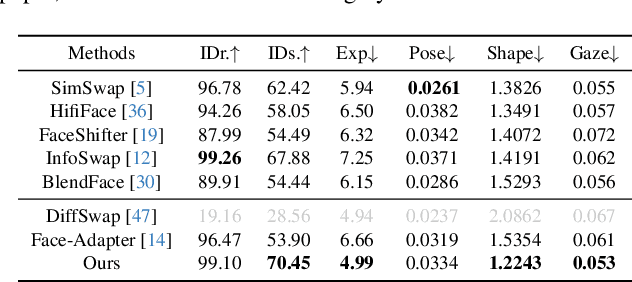


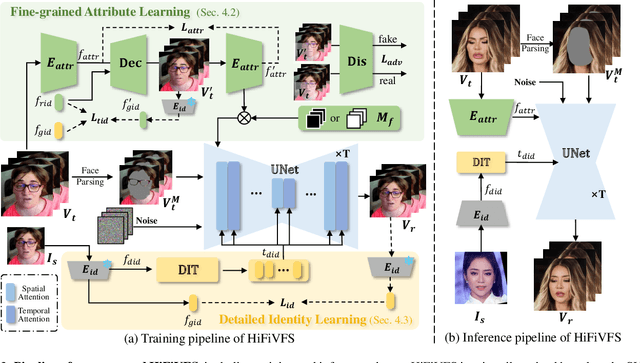
Abstract:Face swapping aims to generate results that combine the identity from the source with attributes from the target. Existing methods primarily focus on image-based face swapping. When processing videos, each frame is handled independently, making it difficult to ensure temporal stability. From a model perspective, face swapping is gradually shifting from generative adversarial networks (GANs) to diffusion models (DMs), as DMs have been shown to possess stronger generative capabilities. Current diffusion-based approaches often employ inpainting techniques, which struggle to preserve fine-grained attributes like lighting and makeup. To address these challenges, we propose a high fidelity video face swapping (HiFiVFS) framework, which leverages the strong generative capability and temporal prior of Stable Video Diffusion (SVD). We build a fine-grained attribute module to extract identity-disentangled and fine-grained attribute features through identity desensitization and adversarial learning. Additionally, We introduce detailed identity injection to further enhance identity similarity. Extensive experiments demonstrate that our method achieves state-of-the-art (SOTA) in video face swapping, both qualitatively and quantitatively.
Unveil Inversion and Invariance in Flow Transformer for Versatile Image Editing
Nov 26, 2024



Abstract:Leveraging the large generative prior of the flow transformer for tuning-free image editing requires authentic inversion to project the image into the model's domain and a flexible invariance control mechanism to preserve non-target contents. However, the prevailing diffusion inversion performs deficiently in flow-based models, and the invariance control cannot reconcile diverse rigid and non-rigid editing tasks. To address these, we systematically analyze the \textbf{inversion and invariance} control based on the flow transformer. Specifically, we unveil that the Euler inversion shares a similar structure to DDIM yet is more susceptible to the approximation error. Thus, we propose a two-stage inversion to first refine the velocity estimation and then compensate for the leftover error, which pivots closely to the model prior and benefits editing. Meanwhile, we propose the invariance control that manipulates the text features within the adaptive layer normalization, connecting the changes in the text prompt to image semantics. This mechanism can simultaneously preserve the non-target contents while allowing rigid and non-rigid manipulation, enabling a wide range of editing types such as visual text, quantity, facial expression, etc. Experiments on versatile scenarios validate that our framework achieves flexible and accurate editing, unlocking the potential of the flow transformer for versatile image editing.
Sonic: Shifting Focus to Global Audio Perception in Portrait Animation
Nov 25, 2024



Abstract:The study of talking face generation mainly explores the intricacies of synchronizing facial movements and crafting visually appealing, temporally-coherent animations. However, due to the limited exploration of global audio perception, current approaches predominantly employ auxiliary visual and spatial knowledge to stabilize the movements, which often results in the deterioration of the naturalness and temporal inconsistencies.Considering the essence of audio-driven animation, the audio signal serves as the ideal and unique priors to adjust facial expressions and lip movements, without resorting to interference of any visual signals. Based on this motivation, we propose a novel paradigm, dubbed as Sonic, to {s}hift f{o}cus on the exploration of global audio per{c}ept{i}o{n}.To effectively leverage global audio knowledge, we disentangle it into intra- and inter-clip audio perception and collaborate with both aspects to enhance overall perception.For the intra-clip audio perception, 1). \textbf{Context-enhanced audio learning}, in which long-range intra-clip temporal audio knowledge is extracted to provide facial expression and lip motion priors implicitly expressed as the tone and speed of speech. 2). \textbf{Motion-decoupled controller}, in which the motion of the head and expression movement are disentangled and independently controlled by intra-audio clips. Most importantly, for inter-clip audio perception, as a bridge to connect the intra-clips to achieve the global perception, \textbf{Time-aware position shift fusion}, in which the global inter-clip audio information is considered and fused for long-audio inference via through consecutively time-aware shifted windows. Extensive experiments demonstrate that the novel audio-driven paradigm outperform existing SOTA methodologies in terms of video quality, temporally consistency, lip synchronization precision, and motion diversity.
MobileMamba: Lightweight Multi-Receptive Visual Mamba Network
Nov 24, 2024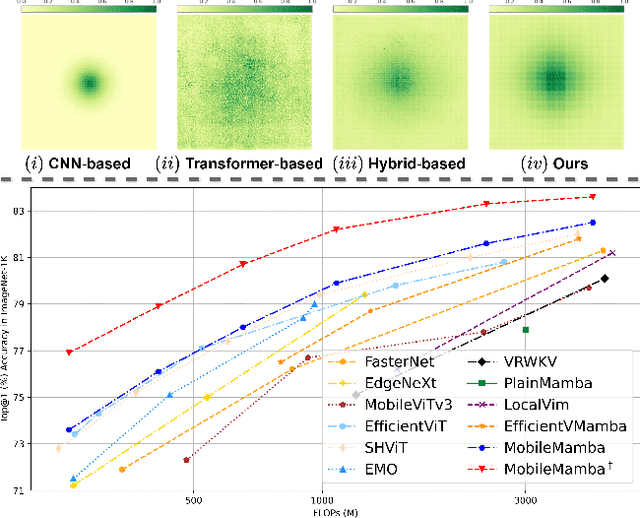
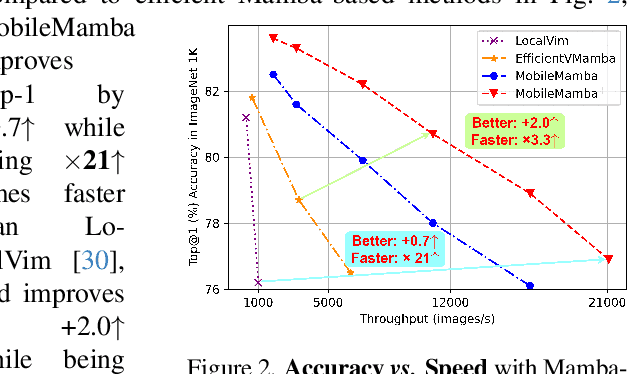

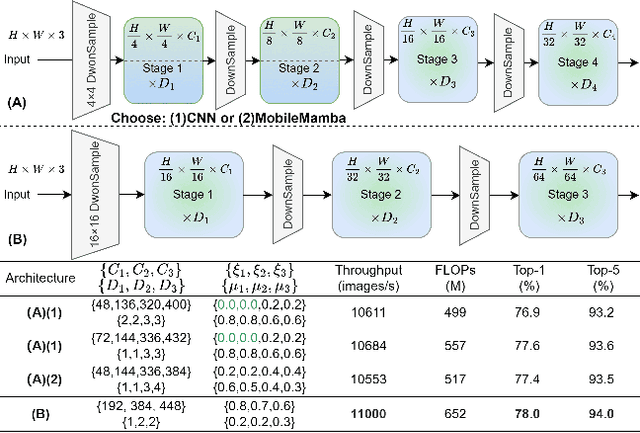
Abstract:Previous research on lightweight models has primarily focused on CNNs and Transformer-based designs. CNNs, with their local receptive fields, struggle to capture long-range dependencies, while Transformers, despite their global modeling capabilities, are limited by quadratic computational complexity in high-resolution scenarios. Recently, state-space models have gained popularity in the visual domain due to their linear computational complexity. Despite their low FLOPs, current lightweight Mamba-based models exhibit suboptimal throughput. In this work, we propose the MobileMamba framework, which balances efficiency and performance. We design a three-stage network to enhance inference speed significantly. At a fine-grained level, we introduce the Multi-Receptive Field Feature Interaction(MRFFI) module, comprising the Long-Range Wavelet Transform-Enhanced Mamba(WTE-Mamba), Efficient Multi-Kernel Depthwise Convolution(MK-DeConv), and Eliminate Redundant Identity components. This module integrates multi-receptive field information and enhances high-frequency detail extraction. Additionally, we employ training and testing strategies to further improve performance and efficiency. MobileMamba achieves up to 83.6% on Top-1, surpassing existing state-of-the-art methods which is maximum x21 faster than LocalVim on GPU. Extensive experiments on high-resolution downstream tasks demonstrate that MobileMamba surpasses current efficient models, achieving an optimal balance between speed and accuracy.
FitDiT: Advancing the Authentic Garment Details for High-fidelity Virtual Try-on
Nov 22, 2024



Abstract:Although image-based virtual try-on has made considerable progress, emerging approaches still encounter challenges in producing high-fidelity and robust fitting images across diverse scenarios. These methods often struggle with issues such as texture-aware maintenance and size-aware fitting, which hinder their overall effectiveness. To address these limitations, we propose a novel garment perception enhancement technique, termed FitDiT, designed for high-fidelity virtual try-on using Diffusion Transformers (DiT) allocating more parameters and attention to high-resolution features. First, to further improve texture-aware maintenance, we introduce a garment texture extractor that incorporates garment priors evolution to fine-tune garment feature, facilitating to better capture rich details such as stripes, patterns, and text. Additionally, we introduce frequency-domain learning by customizing a frequency distance loss to enhance high-frequency garment details. To tackle the size-aware fitting issue, we employ a dilated-relaxed mask strategy that adapts to the correct length of garments, preventing the generation of garments that fill the entire mask area during cross-category try-on. Equipped with the above design, FitDiT surpasses all baselines in both qualitative and quantitative evaluations. It excels in producing well-fitting garments with photorealistic and intricate details, while also achieving competitive inference times of 4.57 seconds for a single 1024x768 image after DiT structure slimming, outperforming existing methods.
 Add to Chrome
Add to Chrome Add to Firefox
Add to Firefox Add to Edge
Add to Edge